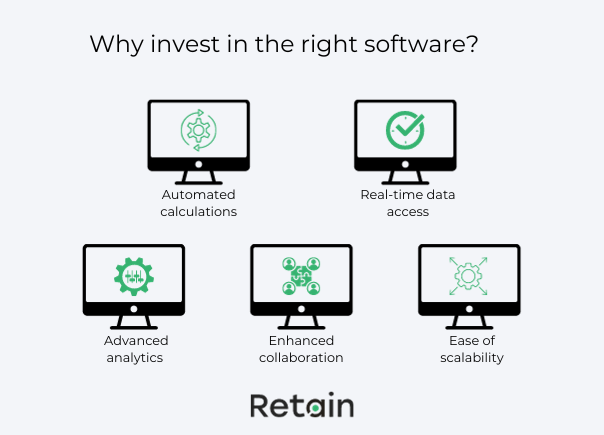Resource capacity planning can make or break your project's success. This isn’t just about the numbers; it’s about aligning workloads, timelines, and team skills availability to deliver results – without burning out your team.
In this guide, we'll delve into resource capacity planning insight and best practices, backed by expert insights from Retain.
In this guide, we cover:
- What resource capacity planning is
- How to calculate resource capacity
- Resource capacity planning key metrics
- Resource capacity planning best practices
- How the right software can help
Let’s get into it.
What is resource capacity planning?
Resource capacity planning helps project and resource managers determine the resources they'll need to meet current and future workflow demands. This isn't just about filling slots; it's about intelligently allocating resources and comparing their capacity against demand.

By doing this, you align the right people with the right tasks at the right time. Understanding this method is non-negotiable for achieving project efficiency and sustainability.
For instance, let's say you manage resources for a consulting firm specialising in financial services, you've got several high-stakes projects on the horizon. Using resource capacity planning, you forecast that you'll be 20% short on risk management experts for a critical quarter.
This deficit could delay projects, negatively affecting revenue and client satisfaction. Now, you have a quantifiable metric and the time to either bring in temporary specialists or adjust project timelines. By doing this, you safeguard your revenue, maintain margins, and uphold your firm's reputation for timely, high-quality service.
How do you calculate resource capacity?
Calculating resource capacity may seem daunting, but it doesn't have to be. It essentially boils down to two elements: availability and demand.
- Availability: The total hours that a resource can work.
- Demand: The total hours that a resource is expected to work based on allocated tasks.
To get started, subtract the demand from the availability of each team member.
Example in practice: Continuing with our financial services consulting firm, you have a risk management expert available for 40 hours a week. After allocating tasks, you realise the demand on them is 35 hours a week. That leaves a buffer of 5 hours, which can be crucial for unexpected tasks or revisions.

By applying these calculations across your team, you can identify who is under- or over-allocated, enabling more effective resource planning.
Resource capacity planning: the key metrics

Effective resource capacity planning is incomplete without a keen eye on specific metrics. These measurements don't just quantify your current state; they guide future planning. So let’s take a look:
1. Utilisation rate
Simply put, utilisation rate is the percentage of time a resource is working on billable projects compared to their available time. It's calculated as:
UtilisationRate=(BillableHours/AvailableHours)x100
For example, in a financial services consulting firm, if your risk management expert has 30 billable hours out of an available 40, their utilisation rate is 75%. An optimal utilisation rate ensures you're neither overburdening nor underutilising your team.
2. Demand forecasting
This is the act of estimating the amount and types of resources you'll need in the future. Understanding demand helps you to allocate resources more effectively.
Let’s say your firm expects an influx of regulatory compliance projects. Demand forecasting alerts you to this surge, enabling you to allocate more resources or even hire new experts in this area.
3. Resource cost rates
This metric helps you understand the cost implications of each resource. It’s crucial for determining project profitability.
Knowing that your senior risk management expert costs £150 per hour while a junior costs £75 helps you balance cost with the need for expertise on various projects.
4. Skill availability
This metric involves tracking the availability of various skills within your team. It's essential for matching specific skills to project requirements.
For example, if your firm is heavy on risk management but light on compliance, it might be time to reskill some team members or consider future hires in the compliance area.
Next up, let's delve into some resource capacity planning best practices that you can implement straight away. These tips have taken your planning to the next level.?
Resource capacity planning best practices

Struggling with all the ins and outs of resource capacity planning? Fret not. Our best practices offer valuable insights to keep your projects sailing smoothly. And as a bonus, we have a recommendation that integrates technology for optimum results.
Monitor time and effort closely
To make your forecasts as accurate as possible, you need precise data on the time and effort that tasks demand. Encourage team members to log time spent on tasks for a reality-based view of workloads.
Spot the bottlenecks
Keep an eye out for obstacles that could slow down your workflow. It could be a lack of skilled personnel, or even equipment. Identifying these bottlenecks in advance saves you from surprises later.
Diversify your inputs
Capacity vs. demand isn't a simple equation. Factor in variables like role, skill set, department, and location when determining your resources' actual capacity.
Stay current on skills
An effective plan needs up-to-date data. Keep tabs on your team's evolving skill sets. That way, if someone leaves or gains new skills, you can adapt your plan on the fly.
Factor in the unexpected
Prepare for unplanned hiccups. Buffering extra time into your plan provides leeway for any last-minute surprises. Then, if things go smoothly, you’re ahead of the game.
Assess true work time
A standard eight-hour workday seldom equals eight productive hours. Recognise the "hidden" time drains—like meetings and emails—and adjust your planning.
Customise to your industry
Every industry has its nuances. Tailor your capacity planning to suit the specific demands and resource skill sets in your sector.
Leverage cutting-edge software
To truly excel in resource capacity planning, implementing robust software is a game-changer. It not only automates the tedious aspects but also offers valuable insights through analytics. If you're serious about maximising your resources, this is one avenue you can't afford to ignore. (More on this next.)
In summary, these best practices offer a practical roadmap for you to follow, laying the foundation for successful projects and a satisfied team.
Considering software for resource capacity planning? It could be the missing puzzle piece for your ultimate success. Click here to check out Retain, or keep reading for a quick summary of how it can help.
Make resource capacity planning easier and scalable with software

Implementing the right software for resource capacity planning doesn't have to be a daunting task.
Here's why you should invest:
#1: Automated calculations
Manually calculating utilisation rates and demand forecasts can be time-consuming and prone to error. Software automates these processes, freeing up time for more strategic work.
#2: Real-time data access
The right software provides a centralised database where you can access real-time information on resource availability, skill sets, and more. This improves your response time when adjusting plans.
#3: Advanced analytics and customised reports
Use data analytics and customised resource management reports to make informed decisions. From predicting resource bottlenecks to understanding profitability, analytics give you the edge.
#4: Enhanced collaboration
With features like shared access controls and read or view edit rights, software solutions provide better and secure communication among team members. This leads to more efficient project execution.
#5: Scalability
As your business grows, your resource planning needs will too. Software solutions can easily adapt to increased demands, making them a long-term investment.
The right software not only makes resource capacity planning simpler, but also adds a layer of precision and scalability that manual methods can't match. If you're on the fence about making the leap, now is the time to consider it seriously.
Leverage resource capacity software
To sum up, resource capacity planning is not a nice-to-have; it's a must-have for any professional services firm. We've dived deep into what it is, how to calculate it, and the key metrics that should be on your radar.
Remember, numbers don't lie. Your metrics can reveal a lot, from utilisation rates to skill availability, painting a clear picture of your project's health. By keeping a keen eye on these, you're not just surviving in your role; you're excelling in it.
Need that extra edge? Retain offers resource management solutions tailored for your specific needs, making your journey in capacity planning seamless and effective. Reach out to us for a personalised demo today.
Looking for more insights? Dive into our library of articles and guides to keep mastering the art of resource management.


